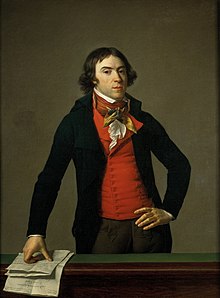Bertrand Barère
| Bertrand Barère | |
|---|---|

portrait of Barère by Jean-Louis Laneuville
|
|
| Deputy for the Third Estate of the Estates-General Constituency of Bigorre |
|
|
In office 6 May 1789 – 17 June 1789 |
|
| Deputy to the National Convention | |
|
In office 20 September 1792 – 27 July 1794 |
|
| Member of the Committee of Public Safety | |
|
In office 7 April 1793 – 27 July 1794 |
|
| Personal details | |
| Born |
10 September 1755 Tarbes, France |
| Died | 13 January 1841 (aged 85) Paris, France |
| Nationality | French |
| Political party |
Feuillants Club (1791–1792) Jacobin Club (1792–1795) Independent (1795–1799) Bonapartist (1799–1814) Legitimist (1814–1815) |
| Other political affiliations |
The Gironde (1791–1793) The Mountain (1793–1795) |
| Profession | Lawyer, journalist and politician |
| Signature |  |
Bertrand Barère de Vieuzac (10 September 1755 – 13 January 1841) was a French politician, freemason, journalist, and one of the most prominent members of the National Convention during the French Revolution.
Betrand Barère was born in Tarbes, a commune part of the Gascony region. The name Barère de Vieuzac, by which he continued to call himself long after the abolition of feudalism in France, originated from a small fief belonging to his father, Jean Barère, who was a lawyer at Vieuzac (now Argelès-Gazost). Barère’s mother, Jeanne-Catherine Marrast, was of old nobility. Barére attended parish school when he was a child, and by the time he was of age, his brother, Jean-Pierre, became a priest.[3] After finishing school, Barère attended a college before he began his career in revolutionary politics. He began to practice as a lawyer at the parlement of Toulouse in 1770, and soon earned a reputation as an orator. However, his fame as an essayist was what led to his election as a member of the Academy of Floral Games of Toulouse in 1788.
He married at the age of thirty. Four years later (1789), he was elected deputy by the estates of Bigorre to the Estates-General — he had made his first visit to Paris in the preceding year. Barère de Vieuzac at first belonged to the constitutional party, but he was less known as a speaker in the National Constituent Assembly than as a journalist. According to François Victor Alphonse Aulard, Barére's paper, the Point du Jour, owed its reputation not so much to its own qualities as to the depiction of Barére in the Tennis Court Oath sketch. The painter, Jacques-Louis David, illustrated Barère kneeling in the corner and writing a report of the proceedings for posterity.
...
Wikipedia
